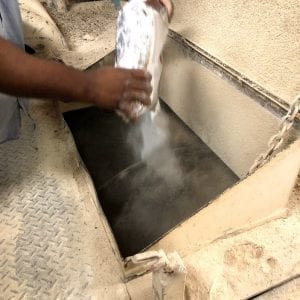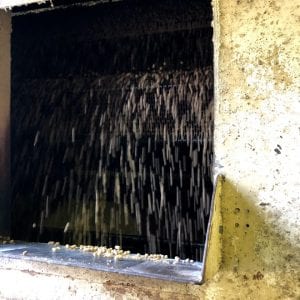Aquaculture

Bacterial diseases are a common problem for commercial catfish producers in Alabama. It is important that your veterinarian or fish health specialist make a diagnosis so that the appropriate antibiotic is used to treat the disease affecting your fish. It is also important to follow requirements and guidelines for antibiotic feed amount and storage to ensure healthy, profitable catfish production.
Antibiotic Feeds
Diseases are a common problem for commercial catfish producers in Alabama. The primary diseases faced by catfish farmers in Alabama are the bacterial diseases columnaris (Flavobacterium columnare), Aeromonas (virulent Aeromonas hydrophila), and enteric septicemia of catfish (Edwardsiella ictaluri, or ESC). These diseases cause millions of dollars in lost profits on catfish farms every year.
As with humans, antibiotics can be effective in fighting bacterial infections in catfish. Catfish are medicated using feed that contains the antibiotic. This feed is fed to the sick population of fish for a specific time.
There are only three antibiotics available for catfish farmers to fight bacterial diseases. These include Aquaflor/Paqflor (florfenicol), Romet (sulfadimethoxine and ormetoprim), and Terramycin 200 (oxytetracycline hydrochloride). Due to the large financial investment and preliminary testing required to develop new antibiotics, it is unlikely that any new antibiotics will be approved for use by the catfish industry anytime soon.
The first step in obtaining an antibiotic treatment is for a veterinarian or fish health specialist to examine your catfish to determine which bacterial disease is present. To locate a fish health specialist, contact the Alabama Fish Farming Center. Upon making a diagnosis, the fish health specialist writes a report and sends it to your veterinarian, who will then write a veterinary feed directive (VFD). The Food and Drug Administration (FDA) requires a VFD from a licensed veterinarian to prevent the abuse and overuse of antibiotic feeds and thus prevent antimicrobial resistance. The veterinarian sends the VFD to an antibiotic-certified feed mill to make (figures 1 and 2) and deliver the medicated feed to the farm. The VFD is valid for up to 6 months; once expired, the VFD feed cannot be fed per FDA regulations.
- Figure 1. Adding the antibiotic to the mixer to ensure that it is equally distributed throughout the feed.
- Figure 2. Medicated feed being dried at a feed mill.
The extra-label use of VFD drugs is prohibited in the United States. Extra-label use is defined in FDA regulations as the actual or intended use of a drug in an animal in a manner that is not following the approved labeling. For example, feeding fish Romet for 10 days instead of 5 days is considered extra-label use and is illegal. Another example would be feeding Aquaflor for an Aeromonas infection when it is approved for use in catfish for columnaris disease, ESC, and Streptococcus infections only (table 1). Terramycin 200 is the antibiotic approved to treat Aeromonas infection.
Table 1. FDA-Approved Antibiotics for Use in Catfish Aquaculture
| Antibiotic Active Ingredient (Brand Name) | For Treatment of | Treatment and Withdrawal Periods | Storage Conditions |
|---|---|---|---|
| Florfenicol (Aquaflor, Paqflor) | Columnaris disease, Enteric septicemia of catfish (ESC), Streptococcus infections | Feed for 10 consecutive days. 15-day withdrawal time. | Store at temperatures up to 77° F with occasional storage permitted to 104° F. |
| Sulfadimethoxine/Ormetoprim (Romet 30 and Romet TC) | ESC | Feed for 5 days. 3-day withdrawal time. | Store dry at or below 77° F with occasional storage permitted to 99° F. |
| Oxytetracycline (Terramycin 200) | Aeromonas, Pseudomonas infections, Columnaris | Feed for 10 days. 21-day withdrawal time. | Store at room temperature (77° F). |
Antimicrobial Resistance
Antimicrobial resistance is the ability of a diseasecausing microbe (such as bacteria) to develop the ability to survive an antimicrobial agent (such as an antibiotic) that was previously effective for treatment. In other words, antimicrobial-resistant bacteria can survive the antibiotics designed to kill them.
Antimicrobial resistance is a problem in many sectors of animal agriculture, including aquaculture. The use of antibiotic feeds in the catfish industry is helpful in combatting bacterial infections; however, both sick and healthy fish eat the medicated feed, increasing the chance of resistance over time. In addition, since ponds are closed-production systems, uneaten medicated feed may stay in the pond environment and even be deposited in pond sediment, again promoting the development of bacteria that are resistant to antibiotics. There are, in fact, documented cases of bacteria that are resistant to some of the common antibiotics, such as Romet or Terramycin 200, which are used by catfish farmers.
Managing Antibiotic Feed at the Farm
Sick catfish require the appropriate amount of antibiotic feed to recover from disease. When a disease is diagnosed in your pond, it is very important to feed your catfish the required amount of antibiotic feed for the recommended time as shown in table 1. For example, if your catfish stop dying after feeding Aquaflor for 4 days, do not stop feeding them medicated feed. Continue to feed them an additional 6 days per the treatment recommendation as Aquaflor is a 10-day treatment. Short-term feeding of antibiotics enables bacteria to develop resistance to that antibiotic. Eventually, the antibiotic will no longer work against the bacteria, resulting in higher fish mortality and fewer effective antibiotics for use in fish.
It is also essential to feed your sick catfish as much feed as your healthy fish. If you are feeding your fish 1,500 pounds a day with nonmedicated feed, you should feed them as close to 1,500 pounds per day of medicated feed. Sometimes sick fish do not eat as vigorously as healthy fish, but feed them what they will eat. Do not limit the amount of feed to half or a quarter of the regular feeding amount to save money as this too promotes the development of antibiotic-resistant bacteria, and more fish will die because they did not have access to medicated feed.
It is also crucial to abide by the withdrawal times listed on the antibiotic feed label (table 1). The United States Department of Agriculture Food Safety Inspection Service (USDA FSIS) monitors antibiotic residues in catfish flesh periodically using fish samples taken at processing plants. The harvest of fish that have been fed an antibiotic feed and not gone through the entire withdrawal period could result in detection of an antibiotic residue in your catfish. The detection of antibiotic residue in catfish will lead to a recall of the product from the supply chain and result in problems for the processor and your farm.
Storing Feed
Properly storing antibiotic feed on the farm is a must. Optimal storage conditions for antibiotic feed are dry conditions at temperatures listed in table 1. If you are storing feed outside in a feed bin or feed truck, chances are the temperature of the feed is going to equal or exceed that of the surrounding air temperature. This is especially true during the summer months when feed bins can heat up due to higher temperatures. Do not store medicated feed for long periods of time during the hot summer or for longer than the recommended treatment period as this will lead to degradation over time and affect the effectiveness of the antibiotic. Order only the amount of antibiotic feed that you need to treat the infection you currently have. This approach will reduce or eliminate the need to store medicated feed and ensures that your catfish receive the amount of antibiotic required.
Summary
- Properly using antibiotic feed and helping prevent antimicrobial resistance requires the following:
- Have a veterinarian or fish health specialist make a diagnosis.
- Use the appropriate antibiotic for the disease affecting your fish.
- Feed the catfish the prescribed amount of antibiotic for the required number of days.
- Follow the withdrawal time guidelines for the antibiotic used to treat your fish.
- Store antibiotic feed properly.
For more information on the proper use of antibiotic feeds, please see Antibiotic Feeds for Catfish Farmers on the Alabama Extension website or contact the Alabama Fish Farming Center.
 Anita Kelly, Extension Professor, and Luke Roy, Extension Professor, both in the School of Fisheries, Aquaculture, & Aquatic Sciences, Auburn University
Anita Kelly, Extension Professor, and Luke Roy, Extension Professor, both in the School of Fisheries, Aquaculture, & Aquatic Sciences, Auburn University
Revised June 2025, Using Medicated Feeds in Catfish Aquaculture, ANR-2758



